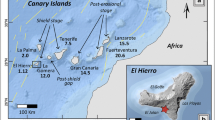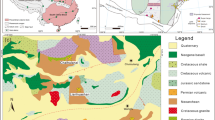Summary
Three generations of fluid inclusions can be recognized in upper mantle xenoliths from alkali basalts of the Somoncura Massif, Northern Patagonia, Argentina. The first (“early”, “primary”) one consists of dense CO2 inclusions which were trapped in the mantle-crust boundary zone (22–36 km minimum trapping depth). Their co-genetic relationship with silicate melt inclusions enables us to constrain their minimum trapping temperature at 1200°C, indicating a high temperature event in a cooler environment. The “late” (“pseudosecondary” and “secondary”) generations of fluid inclusions were classified in accordance with their homogenization temperature to liquid CO2 (L1) and vapor CO2 (L2) phase. The minimum trapping depth for the first of the late inclusions (L1) is about 16 km. In spite of the uncertainties related to this value, L1 inclusions indicate that the upper mantle rocks, of which samples were delivered by the basalts, had some residence time in the middle crust where they experienced a metasomatic event. The fact that this event did not destroy the earlier inclusions, places severe constraints on its duration. The second late inclusions (L2) are low-pressure CO2 inclusions with a minimum trapping depth of only 2 km, presumably a shallow magma chamber of the host basalts. The succession of fluid inclusions strongly points toward a fairly fast uprising upper mantle underneath Northern Patagonia. The petrology and mineral chemistry of the peridotitic xenoliths support this view. Extensive partial melting and loss of these melts is indicated by the preponderance of harzburgites in the upper mantle underneath Northern Patagonia, a fairly unusual feature for a continental upper mantle. That depletion event as well as several metasomatic events — including those which left traces of fluid inclusions — are possibly related to a high-speed diapiric uprise of the upper mantle in this area. The path can be traced from the garnet peridotite stability field into the middle crust, a journey which must have been unusually fast. Differences in rock, mineral, and fluid inclusion properties between geographic locations suggest a diffuse and differential type of diapirism. Future studies will hopefully help to map the full extent and the highs and lows of this diapir and elucidate questions related to its origin and future.
Zusammenfassung
Erdmantel - Xenolithe in Alkali-Basalten des Somoncure Massivs, Nord-Patagonien, Argentinien, führen drei Generationen von Fluid-Einschlüssen. Die erste (“frühe”, “primäre”) Generation besteht aus dichten CO2-Einschlüssen, welche offenbar in der Mantel-Kruste Grenzzone (22–36 km Minimum-Tiefe) eingeschlossen wurden. CO2-Einschlüsse sind kogenetisch mit Silikat-Schmelzeinschlüssen. Dies erlaubt die Abschätzung der Einschließ-Temperatur mit minimal 1200°C, was auf ein Hochtemperatur-Ereignis in einer deutlich kühleren Umgebung hinweist. Die “späten” (“pseudosekundäre” und „sekundäre”) CO2- Fluid-Einschlüsse bilden zwei Generationen von denen die eine in die flüssige (L1), die andere in die Dampfphase (L2) homogenisieren. Die minimale Einschließ-Tiefe für die L1 Generation ist etwa 16 km. Dies bedeutet - auch bei Berücksichtigung der mit diesem Wert verbundenen Ungenauigkeit - daß diese Erdmantel-Gesteine einige Zeit in der mittleren Erdkruste verbrachten und ein metasomatisches Ereignis erlebten, bevor sie von den Basalten zur Erdoberfläche gebracht wurden. Die Tatsache, daß dieses Ereignis die frühen Einschlüsse nicht zerstörte, kann nur bedeuten, daß es von kurzer Dauer war. Die L2-Generation besteht aus Niedrigdruck CO2-Einschlüssen mit einer Minimum-Einschließtiefe von nur 2 km. Dies könnte in einer seichten Magmakammer des Wirt Basaltes geschehen sein.
Die Abfolge von Fluid-Einschlüssen deutet auf einen relativ schnell aufsteigenden oberen Erdmantel unterhalb von Patagonien hin. Die Petrologie und Mineralchemie der peridotitischen Xenolithe unterstützen das. Die Vorherrschaft von Harzburgiten im Erdmantel unterhalb von Nord-Patagonien deutet auf umfangreiche Bildung partieller Schmelzen und deren Abfuhr hin — eine für einen kontinentalen Mantel ungewöhnliche Situation. Sowohl die Verarmungsereignisse, als auch die metasomatischen Veränderungen (einschließlich jene, welche Spuren in Form von Fluid Einschlüssen hinterließen) machen das Vorhandensein eines schnell aufsteigenden Daipirs im oberen Erdmantel dieser Gegend wahrscheinlich. Der Aufstieg kann vom Stabilitätsbereich der Granat-Peridotite bis in die mittlere Kruste verfolgt werden und muß daher relativ schnell erfolgt sein. Unterschiede in Gesteins-, Mineral und Fluid-Eigenschaften zwischen verschiedenen Lokalitäten legen einen diffusen und differenziellen Diapirismus nahe. Zukünftige Studien sollten es ermöglichen, das Gesamtausmaß und die unterschiedlichen Aufstiegshöhen des Diapirs zu kartieren und Hinweise auf seine Entstehung und zukünftige Entwicklung zu erhalten.
Similar content being viewed by others
References
Amundsen HEF (1987) Peridotite xenolith from Gran Canaria, Canary Islands; evidence of metasomatic processes and partial melting in the lower crust. N Jb Mineral Abh 156 2: 121–140
Andersen T, O Reilly SY, Griffin WN (1984) The trapped fluid phases in upper mantle xenoliths from Victoria, Australia: implication for mantle metasomatism. Contrib Mineral Petrol 88: 72–85
Bilal A, Touret J (1976) Fluid inclusions in catazonal xenoliths from Bournac (Massif Central, France). Bull Soc Fr Mineral Crist 100: 324–328
Bjerg ER, Labudía CH, Cesaretti N (1991) Mineralogy, texture and stress measurements of mantle xenoliths from Southern Argentina. Eur J Mineral 3: 31
Brey GP, Köhler T (1990) Geothermobarometry in four-phase lherzolites. II. New themobarometers, and practical assessment of existing thermobarometers. Geochim Cosmochim Acta 31: 1353–1378
Burruss RC (dy1981) Analysis of phase equilibria in C606H6S fluid inclusions. In:Hollister LS, Crawford ML (eds) Short course in fluid inclusions applications to petrology. Short course handbook, vol 6. Mineral Assoc Canada, pp 39–74
Coira BL (1979) Descripcion geologica de la Hoja 40d Ingeniero Jacobacci. Provincia de Rio Negro. Serv/Geol Nac Buenos Aires, Bolet No 168: 1–94
Coisy P, Nicolas A (1978) Regional structure and geodynamics of the Massif Central. Nature (London) 274: 429–432
De Vivo B, Frezzotti ML, Lima A, Trigila R (1988) Spinel lherzolite nodules from Oahu island (Hawaii): a fluid inclusion study. Bull Mineral 111: 307–319
Frezzotti ML, De Vivo B, Clocchiatti R (1991) Melt-mineral-fluid interactions in ultramafic nodules from alkaline lavas of Mount Etna (Sicily, Italy): melt and fluid inclusion evidence. J Volcanol Geotherm Res 47: 209–219
Frezzotti ML, Burke EAJ, De Vivo B, Stefanini B, Villa I (1992) Mantle fluids in pyroxenite nodules from Salt Lake Crater (Oahu, Hawaii). Eur J Mineral 4: 1137–1153
Gelos EM, Hayase K (1979) Estudio de inclusiones peridotiticas en rocas basalticas de la region de Comallo y otras localidades de Rio Negro y Chubut. 6 Cong Geolog Arg Buenos Aires 2: 69–81
Gelos EM, Labudia CH (1981) Estudio de los basaltos con anfiboles y rocas asociadas de las Sierra de QuepuNiyeu, Prov. de Rio Negro. Rep Arg 1981 8 Cong Geolog Arg 4: 921–933
Hansteen TH, Andersen T, Neumann ER, Jelsma H (1991) Fluid and silicate glass inclusions in ultramafic and mafic xenoliths from Hierro, Canary Islands: implications for mantle metasomatism. Contrib Mineral Petrol 107: 242–254
Holloway JR (1981) Compositions and volumes of supercritical fluids in the earth's crust. In:Hollister LS, Crawford ML (eds) Short course in fluid inclusions. Min Assoc Can 6: 13–38
Kempton PD (1987) Mineralogic and geochemical evidence for differing styles of metasomatism in spinel lherzolite xenoliths: enriched mantle source regions of basalts. In:Menzeis MA, Hawkeswoth CJ (eds) Mantle metasomatism. Academic Press, London, pp 45–90
Kennedy GC (1954) Pressure-volume-temperatue relations in CO2 at elevated temperatures and pressures. Am J Sci 252: 225–241
Kerkhof AM van den (1990) Isochoric phase diagram in the system CO2-CH4 and CO2-N2: application to fluid inclusions. Geochim Cosmochim Acta 54: 621–629
Kerkhof AM van den, Olsen SN (1990) A natural example of superdense C02 inclusions: microthermometry and Raman analysis. Geochim Cosmochim Acta 54: 895–901
Kirby SH, Green HW (1980) Dunite xenoliths from Hualalai volcano: evidence for mantle diapiric flow beneath the island of Hawaii. Am J Sci 280-A: 550–575
Kurat G, Embey-Isztin A, Kracher A, Scharbert HG (1991) The upper mantle beneath Kapfenstein and the Transdanubian Volcanic Region, E Austria and W Hungary: a comparison. Mineral Petrol 44: 21–38
Labudia CH, Bjerg ER (1981) Petrografia de la zona norste de la localidad de Los Menucos, Provincia de Rio Negro. 8 Cong Geolog Arg Buenos Aires Actas 4: 841–852
Labudia CH, Bjerg EA, Gregori DA (1984) Nodulos de composicion ultrabasica de las lavas alcalinas de la localidad de Praguaniyeu, prov. de Rio Negro. 9 Cong Geolog Arg Actas Buenos Aires 2: 547–553
Labudia CH, Cesaretti N, Bjerg EA (1987) Nodulos lherzoliticos en basaltos alcalinos del Bajo de Lenzaniyeu, Prov. de Rio Negro. Rep. Arg. Simposio International de vulcanismo Andino. 10 Cong Geolog Arg Tucuman 4: 177–179
Labudia CH, Bjerg EA, Cesaretti N (1989) Nodulos lherzoliticos en basaltos alcalinos del Bajo de Lenzaniyeu, prov. de Rio Negro, Republica Argentina. Asoc Geolog Arg Rev 44: 217–223
Labudia CH, Cesaretti N, Bjerg EA (1992) Procesos de deformacion en et manto inferidos a traves de los nodulos lherzoliticos incluidos en los basaltos alcalinos del area de Lenzaniyeu, prov. de Rio Negro, Argentina. 7 Reun Microt Bahia Blanca 1: 7–14
Lin-Qi Xia, Massare D, Clocchiatti R (1983) Thermobarochimie de quelques nodules de peridotite contenus dans les basalts alcalins néogénes de Chine orientale. C R Acad Sci Paris t 297, Série 11: 675–680
Llambias EJ, Rapela CW (1984) Geologia de los complejos eruptivos de La Esperanza, Provincia de Rio Negro. Revista de la Asoc Geolog Arg Rev 39 (3-4): 220–243
Mercier J, Nicolas A (1975) Textures and fabrics of upper mantle peridotites as illustrated by xenoliths from basalts. J Petrol 16: 454–487
Nixon PH (ed) (1987) Mantle xenoliths. J Wiley & Sons, Chichester, 844pp
Nullo FE (1978) Descripcipn geologica de la Hoja 41d, Lipetren, provincia de Rio Negro. Serv Geolog Nac Buenos Aires Bol No 158: 1–88
Roedder E (1983) Geobarometry of ultramafic xenoliths from Loihi Seamount, Hawaii, on the basis of CO2 inclusions in olivine. Earth Planet Sci Lett 66: 369–379
Roedder E (1984) Fluid inclusions. Mineral Soc Am Rev Mineral 12: 1–644
Schiano P, Clocchiatti R (1994) Worldwide occurrence of silica-rich melts in subcontinental and sub-oceanic mantle minerals. Nature (London) 368: 621–624
Schiano P, Clocchiatti R, Shimizu N, Weis D, Mattielli N (1994) Cogenetic silica-rich and carbonate-rich melts trapped in mantle minerals in Kerguelen ultramafic xenoliths: implication for metasomatism in the oceanic upper mantle. Earth Planet Sci Lett 123: 167–178
Stern CR, Futa K, Saul S, Skewes MA (1986) Nature and evolution of the subcontinental mantle Lithosphere below southern South America and implications for Andean magma genesis. Rev Geol Chile 27: 41–53
Stern CR, Saul S, Skewes MA, Futa K (1989) Garnet peridotite xenoliths from the Pali-Aike basalts of southernmost South America. In: Kimberlites and related rocks. Geol Soc Australia, Spec Publ 14. Blackwell, Carlton, Australia 2: 735–744
Stern CR, Frey FA, Futa K, Zartman RE, Peng Z, Kyser TK (1990) Trace-element and Sr, Nd, Pb, and O isotopic composition of Pliocene and Quaternary alkaline basalts of the Patagonian Plateau lavas of southernmost South America. Contrib Mineral Petrol 104: 294–308
Stipanicic PN, Methol EJ (1980) Comarca Norpatagonica. In: II Simp Geolog Reg Arg Acad Nac Cs Cordoba 2: 1071–1097
Touret JLR (1982) An emphirical phase diagram for a part of the system N2-CO2 system at low temperture. Chem Geol 37: 49–58
Vande Car JC, James DE, Assumpsao M (1995) Seismic evidence for a fossil mantle plume beneath South America and implications for plate driving forces. Nature (London) 378: 25–31
Wanamarker BJ, Wong TF, Evans Brian (1990) Decrepitation and cracks healing of fluid inclusions in San Carlos olivine. J Goephys Res 95 (B 10): 15, 623–15, 641
Author information
Authors and Affiliations
Additional information
With 5 Figures
Rights and permissions
About this article
Cite this article
Varela, M.E., Bjerg, E.A., Clocchiatti, R. et al. Fluid inclusions in upper mantle xenoliths from Northern Patagonia, Argentina: Evidence for an upper mantle diapir. Mineralogy and Petrology 60, 145–164 (1997). https://doi.org/10.1007/BF01173707
Received:
Accepted:
Issue Date:
DOI: https://doi.org/10.1007/BF01173707




